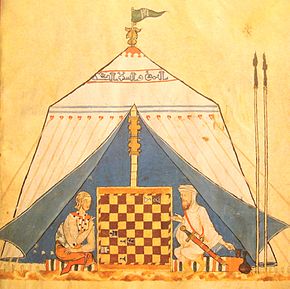
During the High Middle Ages, the Islamic world was an important contributor to the global cultural scene, innovating and supplying information and ideas to Europe, via Al-Andalus, Sicily and the Crusader kingdoms in the Levant. These included Latin translations of the Greek Classics and of Arabic texts in astronomy, mathematics, science, and medicine. Translation of Arabic philosophical texts into Latin "led to the transformation of almost all philosophical disciplines in the medieval Latin world", with a particularly strong influence of Muslim philosophers being felt in natural philosophy, psychology and metaphysics.[2] Other contributions included technological and scientific innovations via the Silk Road, including Chinese inventions such as paper, compass[3][4] and gunpowder.
The Islamic world also influenced other aspects of medieval European culture, partly by original innovations made during the Islamic Golden Age, including various fields such as the arts, agriculture, alchemy, music, pottery, etc.
Many Arabic loanwords in Western European languages, including English, mostly via Old French, date from this period.[5] This includes traditional star names such as Aldebaran, scientific terms like alchemy (whence also chemistry), algebra, algorithm, etc. and names of commodities such as sugar, camphor, cotton, coffee, etc.
- ^ Lebedel, p.109
- ^ Dag Nikolaus Hasse (2014). "Influence of Arabic and Islamic Philosophy on the Latin West". Stanford Encyclopedia of Philosophy. Retrieved 2020-06-03.
- ^ Needham, Joseph. Cambridge University Press. University of California Press. p. 173.
Thus the possibility presents itself that... it may have formed part of one of those transmissions from Asia which we find in so many fields of applied science
- ^ McEachren, Justin W. General Science Quarterly, Volumes 5-6. University of California Press. p. 337.
From the Chinese, the Arabs in all probability learned to use the magnetic needle, and in this round-about fashion it was brought to Europe
- ^ Lebedel, p.113